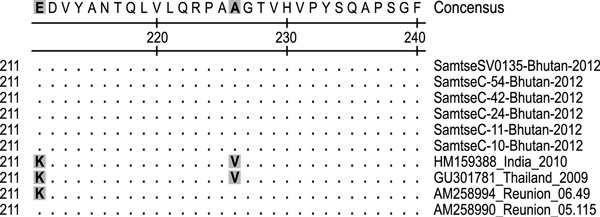Volume 19, Number 10—October 2013
Dispatch
Chikungunya Fever Outbreak, Bhutan, 2012
Figure 2

Figure 2. . Amino acids at positions 211 and 226 of the chikungunya virus (CHIKV) envelope protein 1 (E1) and alignment of aa 211–240 of Bhutan 2012 CHIKV isolates with Réunion Island 2005, Indian 2010, and Thailand 2009 CHIKV isolates. Gray shading indicates residues 211 and 226 of the E1 protein.
Page created: September 16, 2013
Page updated: September 16, 2013
Page reviewed: September 16, 2013
The conclusions, findings, and opinions expressed by authors contributing to this journal do not necessarily reflect the official position of the U.S. Department of Health and Human Services, the Public Health Service, the Centers for Disease Control and Prevention, or the authors' affiliated institutions. Use of trade names is for identification only and does not imply endorsement by any of the groups named above.